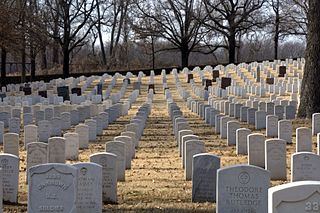
Fort Smith National Cemetery is a United States National Cemetery located at Garland Avenue and Sixth Street in Fort Smith, Sebastian County, Arkansas. It encompasses 22.3 acres (9.0 ha), and as of the end of 2005, had 13,127 interments.

The Fort Smith Trolley Museum is a streetcar and railroad museum in Fort Smith, in the U.S. state of Arkansas, which includes an operating heritage streetcar line. The museum opened in 1985, and operation of its streetcar line began in 1991. Four vehicles in its collection, a streetcar and three steam locomotives, are listed on the National Register of Historic Places (NRHP). The now approximately three-quarters-mile-long (1.2 km) streetcar line also passes four NRHP-listed sites, including the Fort Smith National Historic Site, the Fort Smith National Cemetery, the West Garrison Avenue Historic District and the 1907 Atkinson-Williams Warehouse Building, which now houses the Fort Smith Museum of History.

The Confederate Memorial in Mayfield is a commemorative monument and fountain located on the courthouse lawn in downtown Mayfield, Kentucky.

The Strengthen the Arm of Liberty Monument is a replica of the Statue of Liberty in Pine Bluff Memorial Gardens, on the south side of 10th Avenue between Georgia and State Street in Pine Bluff, Arkansas. It was placed by the Boy Scouts of America (BSA) as part of its 1950s era campaign, "Strengthen the Arm of Liberty." The statue is 8 feet (2.4 m) in height, made of copper, and is mounted on concrete base 3.5 feet (1.1 m) tall. The statue faces north, toward the Pine Bluff Civic Center, and there is a bronze commemorative plaque on the north face of the base. It is one of two BSA-placed statues in the state; the other is in Fayetteville.

U.S. Route 64 is a U.S. highway running from Teec Nos Pos, Arizona east to Nags Head, North Carolina. In the U.S. state of Arkansas, the route runs 246.35 miles (396.46 km) from the Oklahoma border in Fort Smith east to the Tennessee border in Memphis. The route passes through several cities and towns, including Fort Smith, Clarksville, Russellville, Conway, Searcy, and West Memphis. US 64 runs parallel to Interstate 40 until Conway, when I-40 takes a more southerly route.
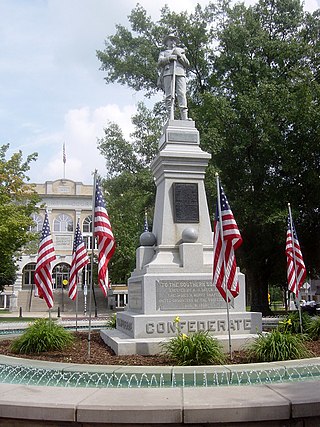
The Bentonville Confederate Monument was installed in Bentonville, Arkansas, United States. It was removed in September 2020.
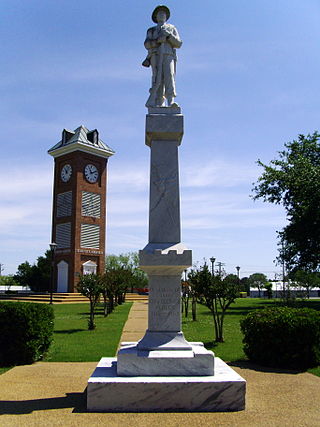
The Star City Confederate Memorial is located at the southwest corner of the town square of Star City, Arkansas. The marble monument depicts a Confederate Army soldier standing in mid stride with his left foot forward. His hands hold the barrel of a rifle, whose butt rests on the monument base. The statue is about 6 feet (1.8 m) high and 2 feet (0.61 m) square; it rests on a marble foundation that is 20 feet (6.1 m) long, 12 feet (3.7 m) wide, and 8 feet (2.4 m) high. The monument was erected in 1926 by a local chapter of the United Daughters of the Confederacy at a cost of about $2,500.
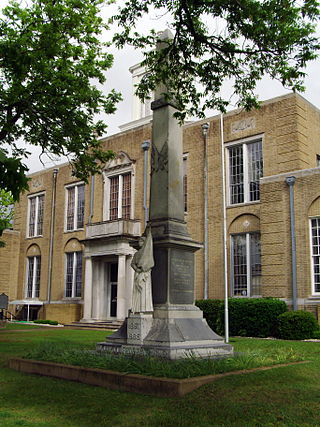
The Camden Confederate Monument, also known as the Confederate Women's Memorial, is located on the grounds of the Ouachita County Courthouse in Camden, Arkansas. The sculpture, carved out of Italian marble, depicts a woman dressed in the period of the American Civil War, standing with her feet together, clutching a flagpole. The sculpture is mounted on a block of North Carolina granite, next to a tall obelisk. The statue is 5 feet (1.5 m) tall. The obelisk is inscribed on three sides, recognizing the valor of women in the Confederate cause, and the organizations that funded the memorial's construction. The memorial was erected in 1914 by the local chapters of the United Confederate Veterans and the United Daughters of the Confederacy.
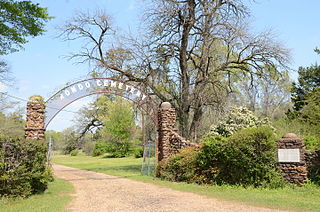
The Old Rondo Cemetery is located at the junction of McClure Road and Cobb Lane in Rondo, a small community in Miller County just northeast of Texarkana, Arkansas. The cemetery is best known for the burial site at its center, where the remains of 85 Confederate Army soldiers are buried. In 1862, during the Union Army advance on Little Rock, Confederate troops stationed at Rondo were swept up in a measles epidemic. The 19th Texas Infantry Regiment had seven companies stationed at Rondo, and most of the dead came from its ranks. The 85 dead were disinterred from their original graves and reburied in the Rondo Cemetery after the war. In 1931 the Texarkana chapter of the United Daughters of the Confederacy received federal funding for the purchase of the plot and the placement of memorial markers. There are 17 markers, one for every five of the unknown soldiers, as well as a sandstone monument placed in 1962 and a historical marker placed in the 1990s on the plot, which is set off from the rest of the cemetery by a low concrete boundary wall.

The Robert E. Lee Monument is a U. D. C. memorial built to honor Lee County's Confederate veterans. The monument was carved by the McNeel Marble Co. It is located in Marianna, Arkansas, across from the Lee County Courthouse. Dedicated in 1910, it is one of several monuments built to honor Confederate soldiers. The structure is a local tourist attraction and, since 1996, has been listed in the National Register of Historic Places.
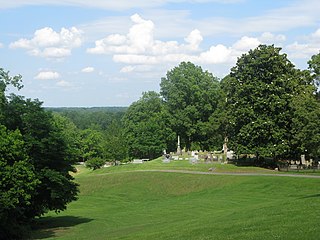
The Helena Confederate Cemetery is located in the southwest corner of the Maple Hill Cemetery on Holly Street in Helena, Arkansas. It is a small section of the larger cemetery, under one acre in size, and is marked by two significant memorials: the Confederate Memorial and the memorial to Confederate Army General Patrick Cleburne, whose burial here is the only known place associated with his life. The Cleburne memorial is a marble shaft 15 feet (4.6 m) in height, topped by an urn with flames coming from its top. The Confederate Memorial is a marble depiction of a soldier, mounted on a 30-foot (9.1 m) granite shaft, surrounded by pyramids of cannonballs and inverted cannons. The cemetery has more than 100 marked graves, 15 of which are unidentified Confederate dead, and 23 are of those killed in the 1863 Battle of Helena.

The St. Charles Battle Monument is located at the center of the intersection of Broadway and Arkansas Street in the center of St. Charles, Arkansas. It commemorates the 1862 Battle of Saint Charles, a naval and land engagement of the American Civil War that took place just downriver from the city. It is a square granite monument, topped by an inverted cannon barrel. It is 18 feet (5.5 m) high and 9.5 feet (2.9 m) square. Its inscriptions commemorate the 148 Union soldiers who died in the explosion of the USS Mound City, caused by what is sometimes described as the single deadliest shot fired in the entire Civil War. Inscriptions on another side memorialize the smaller number of Confederate dead in the engagement. The monument was placed in 1919 through the efforts of a relative of William Hickman Harte, the master on board the Mound City who died in the explosion, and is one of the few memorials placed in a Confederate state by a northerner in commemoration of both Union and Confederate war dead.

The Jackson Guards Memorial is a sculpture commemorating the Jackson Guards, a unit of the Confederate Army, in Arkansas's Jacksonport State Park. The sculpture stands at Washington and Avenue Streets in the park, and depicts a standing male soldier, holding with both hands a rifle, butt on the ground. The marble sculpture is about 6 feet (1.8 m) tall, and is mounted on a granite base 20 feet (6.1 m) tall and 10 feet (3.0 m) square. Funding for the statue was raised by private subscription, and it was unveiled in 1914 in Newport, the county seat of Jackson County. It was moved to its present location in 1965.

The Batesville Confederate Monument is located at the southeast corner of Main and Broad Streets in Batesville, Arkansas. It is a square monument, about 20 feet (6.1 m) in height, divided into four stages, and built out of local limestone. The first three-stage have a base trim element, and are unadorned except for inscriptions. The divider between the first and second stages is a projecting shelf, while that above the second and third stages resembles a turreted battlement. The monument was placed in 1907 by local chapters of the United Daughters of the Confederacy.
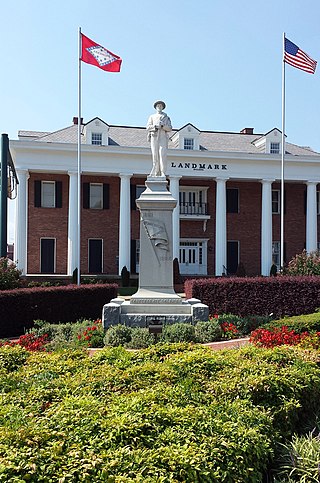
The Hot Springs Confederate Monument is located in Landmark Plaza in central Hot Springs, Arkansas. It is a marble representation of a Confederate Army soldier, manufactured by the McNeel Marble Company of Marietta, Georgia. The figure is 6 feet (1.8 m) tall, and is mounted on a granite base 12 feet (3.7 m) tall and 6 feet square. The monument was placed in 1934 by the local chapter of the United Daughters of the Confederacy, and was the last Confederate monument placed in one of Arkansas' major cities. Lynchings took place at the site in the decades before its construction.

The Pine Bluff Confederate Monument has long been located in front of the Jefferson County courthouse, at Barraque and Main Streets in Pine Bluff, Arkansas. It depicts a standing Confederate Army soldier, holding a rifle whose butt rests on the ground. The statue, built out of Georgia marble by the McNeel Marble Company, stands on a stone base 15 feet (4.6 m) in height and 10 by 10 feet at the base. It was placed in 1910 by the local chapter of the United Daughters of the Confederacy.

The Memorial to Company A, Capitol Guards was an American Civil War memorial in MacArthur Park, Little Rock, Arkansas. It stood just northeast of the former Tower Building of the Little Rock Arsenal, at a junction of two of the park's internal roadways. It consisted of a bronze sculpture depicting a Confederate Army soldier in a defensive stance, holding a rifle pointed forward. The statue was 8 feet (2.4 m) in height, and was mounted in a granite column 16 feet (4.9 m) tall. The memorial was sometimes known as "Lest we forget", a line that appeared near the top of the inscription on the base. The statue was created by sculptor Rudolph Schwarz, and was installed in 1911; it was paid for by the local chapter of the Sons of Confederate Veterans, and memorializes the unit that seized the arsenal at the outset of the war.

The Lonoke Confederate Monument is located in central downtown Lonoke, Arkansas, on the grounds of the Lonoke County Courthouse. It is a marble depiction of a Confederate Army soldier, 6 feet (1.8 m) in height, mounted on a square columnar base almost 15 feet (4.6 m) tall. The soldier holds a rifle, its butt resting on the ground, and carries a bedroll. He has a belt on which there are a canteen and bayonet. The statue was commissioned by the local chapter of the United Daughters of the Confederacy and was unveiled in 1910.

The Searcy Confederate Monument stands on the grounds of the White County Courthouse, near the corner of West Arch Avenue and Spring Streets, in Searcy, Arkansas. It is a marble statue, depicting a Confederate Army soldier, standing at rest with his rifle resting on the ground. The statue is about 6 feet (1.8 m) in height, and is mounted on a granite base that is 16 feet (4.9 m) tall and 6 feet (1.8 m) square. The base is inscribed in commemoration of White County's soldiers who served in the Confederate Army. The statue was placed in 1917; it was funded through a public fund-raising campaign.
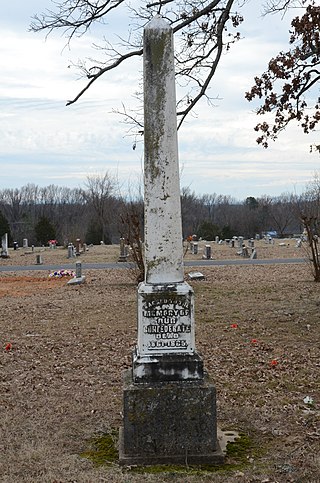
The Clarksville Confederate Monument is located in the south-central section of Oakland Cemetery in Clarksville, Arkansas. It is a white marble obelisk, 10 feet (3.0 m) in height, which is 21.5 inches (55 cm) square at its base. It is mounted on a limestone pedestal 2 feet (0.61 m) square and 22 inches (56 cm) in height. The lower portion of the obelisk is carved with an inscription commemorating the Confederate war dead, and its spire is adorned with a floral pattern. It was placed about 1902 by the local chapter of the United Daughters of the Confederacy.






















